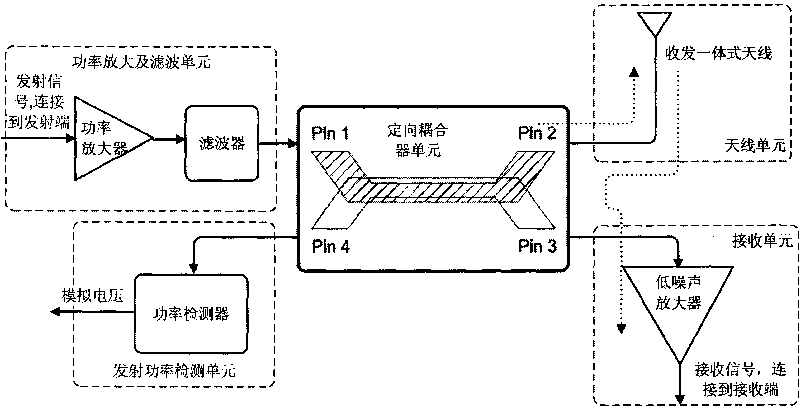Isolating device for UHF-band RFID reader
An isolation device and reader technology, applied in the field of radio frequency identification, can solve the problems of increased manufacturing cost and size, difficulty in achieving isolation, and expensive circulators, and achieve the effects of improving transceiver isolation, low cost, and solving carrier leakage
- Summary
- Abstract
- Description
- Claims
- Application Information
AI Technical Summary
Problems solved by technology
Method used
Image
Examples
Embodiment Construction
[0010] The present invention will be further described below in conjunction with the accompanying drawings and embodiments.
[0011] According to the principle of reciprocity characteristics of the four ports of the directional coupler (input port pin1, output port pin2, isolation port pin3, coupled output port pin4), such as figure 1 and figure 2 As shown, when the transmission signal is input by pin1 through the power amplification and filtering unit, pin2 is the output port, which can be connected to the antenna unit to radiate the signal. When the antenna unit receives the response signal of the tag and is input by pin2, pin3 is now used as the coupling port of the tag response signal, and the tag response signal received by the antenna unit is coupled and output to the receiving unit, and pin3 is input by pin1 The isolation port can effectively attenuate the leakage of the transmission signal of the pin1 pin and the reflection of the transmission signal caused by the mi...
PUM
 Login to View More
Login to View More Abstract
Description
Claims
Application Information
 Login to View More
Login to View More - R&D
- Intellectual Property
- Life Sciences
- Materials
- Tech Scout
- Unparalleled Data Quality
- Higher Quality Content
- 60% Fewer Hallucinations
Browse by: Latest US Patents, China's latest patents, Technical Efficacy Thesaurus, Application Domain, Technology Topic, Popular Technical Reports.
© 2025 PatSnap. All rights reserved.Legal|Privacy policy|Modern Slavery Act Transparency Statement|Sitemap|About US| Contact US: help@patsnap.com



